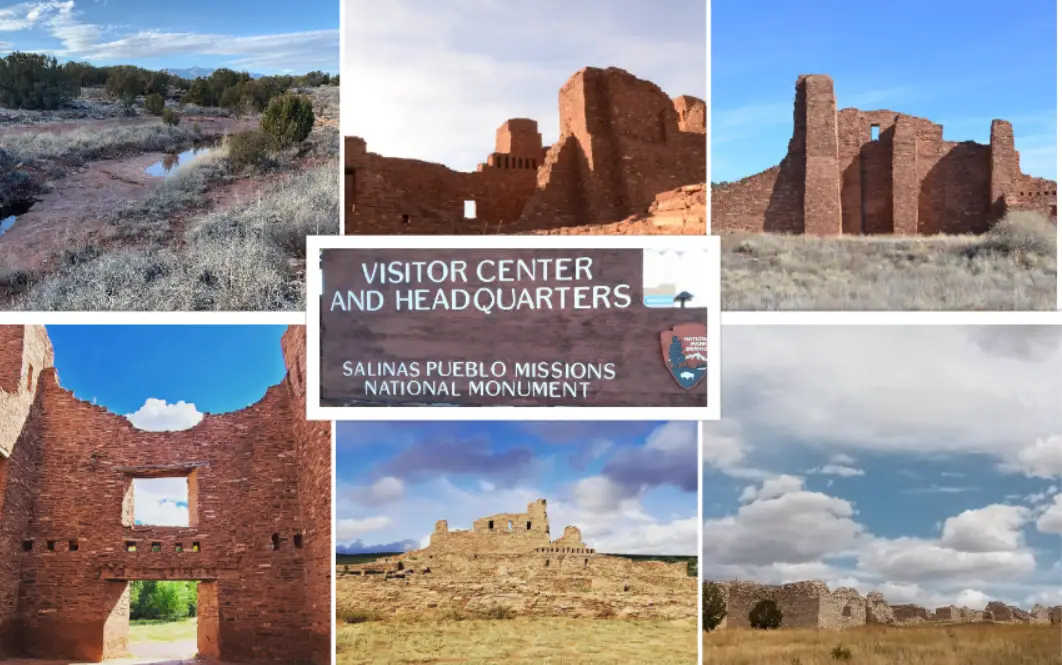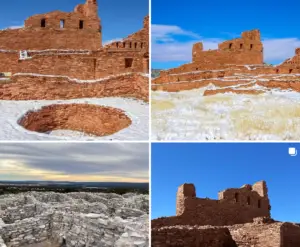Salinas Pueblo Missions National Monument : Interesting Facts, History & Travel Guide

- By
- Aparna Patel
- |
- 13 Apr, 2023
- |

Welcome to our blog about Salinas Pueblo Missions National Monument, a fascinating destination filled with rich history and cultural significance. This National Monument is located in central New Mexico, and it encompasses three separate pueblo mission sites that date back to the 17th century. The ruins of these missions offer a unique glimpse into the lives of the indigenous people who once inhabited this region, as well as the Spanish settlers who came to convert them to Christianity.
In this blog, we’ll delve into the history of the Salinas Pueblo Missions, share interesting facts about the area, and provide a comprehensive travel guide for those interested in exploring this incredible site. So join us on this journey through time as we uncover the secrets of the Salinas Pueblo Missions National Monument.
Table of Contents
Interesting facts about Salinas Pueblo Missions National Monument
- Salinas Pueblo Missions National Monument is located in central New Mexico and protects three Spanish mission ruins and the remains of a historic pueblo.
- The three mission ruins include the Gran Quivira, Quarai, and Abó missions, which were built in the 17th century and are considered to be among the most well-preserved examples of Spanish mission architecture in the Southwest.
- The pueblo ruins at the national monument are believed to have been occupied by the Salinas people from the 14th to the 17th centuries before they were abandoned in the late 1600s.
- The missions were established by the Spanish in the early 1600s as part of their effort to colonize the region and convert the Native American populations to Christianity.
- The national monument was established by President Lyndon B. Johnson in 1980 to protect and preserve the historic sites.
- The site is also an important cultural center for the Puebloan peoples, who have lived in the region for centuries and still maintain strong ties to the land and its history.
- Visitors to the national monument can explore the ruins of the missions and the pueblo, hike trails through the surrounding hills, and learn about the history and culture of the region through interpretive exhibits and ranger-led programs.
- The national monument is also an important site for archaeological research, and ongoing studies have uncovered new insights into the lives of the people who lived and worked there centuries ago.
The Salinas Pueblo Missions National Monument is open year-round, but visitors should be aware that temperatures can be extreme in the summer and snow is common in the winter.
Read More:
- Salinas Pueblo Missions National Monument : Interesting Facts, History
- Russell Cave National Monument : Interesting Facts, History & Travel Guide
- Rose Atoll Marine National Monument : Interesting Facts, History
- Rainbow Bridge National Monument : Interesting Facts, History & Travel Guide
- President Lincoln and Soldiers’ Home : Interesting Facts, History
Information & History of Salinas Pueblo Missions National Monument
Salinas Pueblo Missions National Monument is located in central New Mexico and is managed by the National Park Service. It protects three Spanish mission ruins and the remains of a historic pueblo that were built in the 17th century. The three missions are Gran Quivira, Quarai, and Abó.
The site is also an important cultural center for the Puebloan peoples who have lived in the region for centuries and still maintain strong ties to the land and its history. The Salinas Pueblo Missions National Monument is part of the traditional homeland of the Pueblo people, who are believed to have lived in the area for over a thousand years.
The missions were established by the Spanish in the early 1600s as part of their effort to colonize the region and convert the Native American populations to Christianity. The Spanish believed that the native peoples were “heathens” and that it was their duty to bring them into the Catholic faith. The missions were often built on or near existing Pueblo sites, and the Spanish used the buildings and resources of the native communities to construct the missions.
The missions were staffed by Franciscan friars who were responsible for the spiritual and material welfare of the communities they served. They worked to teach the native peoples about Christianity and European ways of life, but they also provided medical care, education, and other services. The missions were also centers of commerce, and the Spanish traded goods with the native peoples in exchange for food, clothing, and other necessities.
The missions at Salinas Pueblo Missions National Monument were occupied for only a few decades before they were abandoned in the late 1600s. The reasons for their abandonment are not fully understood, but it is believed that a combination of factors, including drought, disease, and conflict with other native groups and Spanish colonizers, contributed to the decline of the communities.
Today, visitors to the national monument can explore the ruins of the missions and the pueblo, hike trails through the surrounding hills, and learn about the history and culture of the region through interpretive exhibits and ranger-led programs. The national monument is also an important site for archaeological research, and ongoing studies have uncovered new insights into the lives of the people who lived and worked there centuries ago.
Travel Guide for Salinas Pueblo Missions National Monument
- Getting there: The national monument is located about 45 minutes south of Albuquerque and about an hour and a half north of Las Cruces. The closest airports are Albuquerque International Sunport and El Paso International Airport. From Albuquerque, take I-25 south to the US 60 exit at Socorro and then follow the signs to the national monument.
- When to visit: The national monument is open year-round, but the best time to visit is in the spring or fall when temperatures are mild. Summers can be hot, and winters can be cold and snowy. The national monument is also closed on Thanksgiving, Christmas Day, and New Year’s Day.
- What to see: The national monument includes three mission ruins (Gran Quivira, Quarai, and Abó) and the remains of a historic pueblo. Visitors can explore the ruins, hike trails through the surrounding hills, and learn about the history and culture of the region through interpretive exhibits and ranger-led programs.
- Fees and permits: There is no entrance fee to visit the national monument, but there may be fees for camping or other activities. Permits may be required for backcountry camping or other activities, so be sure to check with the park rangers before you go.
- Camping and lodging: There is no camping allowed within the national monument, but there are several campgrounds and RV parks in the surrounding area. The nearest towns with lodging options are Mountainair and Socorro.
- Safety and regulations: Be sure to follow all park regulations, including staying on designated trails and respecting the historic ruins. The area is also home to rattlesnakes and other wildlife, so be sure to watch where you step and keep a safe distance from any animals you encounter.
- Nearby attractions: If you have extra time, there are several other attractions in the area worth visiting, including the Bosque del Apache National Wildlife Refuge, the Very Large Array radio telescope, and the White Sands National Park.
Overall, Salinas Pueblo Missions National Monument is a fascinating and historically significant site that offers a glimpse into the rich cultural heritage of the region. Whether you’re interested in history, archaeology, or just enjoying the natural beauty of the area, a visit to this national monument is sure to be a memorable experience.
More Post:
- Pipe Spring National Monument : Interesting Facts, History & Travel Guide
- Petroglyph National Monument : Interesting Facts, History & Travel Guide
- Organ Pipe Cactus National Monument : Interesting Facts, History & Travel Guide
- Prehistoric Trackways National Monument : Interesting Facts, History & Travel Guide
- Pompeys Pillar National Monument : Interesting Facts, History & Travel Guide
FAQ About Salinas Pueblo Missions National Monument
What are the three missions at the national monument?
The three missions are Gran Quivira, Quarai, and Abó. Each mission was established by the Spanish in the early 1600s to convert the Native American populations to Christianity.
When is the best time to visit the national monument?
The best time to visit is in the spring or fall when temperatures are mild. Summers can be hot, and winters can be cold and snowy. The national monument is open year-round.
Is there an entrance fee to visit the national monument?
No, there is no entrance fee to visit the national monument.
Can you camp at the national monument?
No, there is no camping allowed within the national monument. However, there are several campgrounds and RV parks in the surrounding area.
Are there hiking trails at the national monument?
Yes, there are hiking trails that visitors can explore, which offer views of the ruins and the surrounding hills.
Is the national monument accessible to people with disabilities?
Yes, the visitor center and some of the trails are accessible to people with disabilities. The park rangers can provide more information about accessibility.
What other attractions are nearby?
There are several other attractions in the area worth visiting, including the Bosque del Apache National Wildlife Refuge, the Very Large Array radio telescope, and the White Sands National Park.
Can you bring pets to the national monument?
Pets are allowed in the park, but they must be kept on a leash and under control at all times. They are not allowed in the buildings or on the trails.
What should I know before visiting the national monument?
Visitors should be aware of park regulations, including staying on designated trails and respecting the historic ruins. The area is also home to rattlesnakes and other wildlife, so be sure to watch where you step and keep a safe distance from any animals you encounter.
Search Posts
Latest posts
-
5 Mar, 2024
How to avoid drinking vodka?
-
4 Mar, 2024
Can I accidentally miss the in-flight food?
-
4 Mar, 2024
How to make dining alone less awkward?
-
5 Mar, 2024
Why prohibit engine braking?
Popular posts
-
5 Mar, 2024
Why prohibit engine braking?
